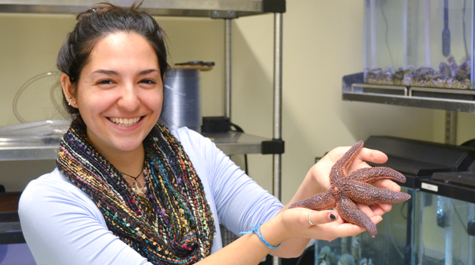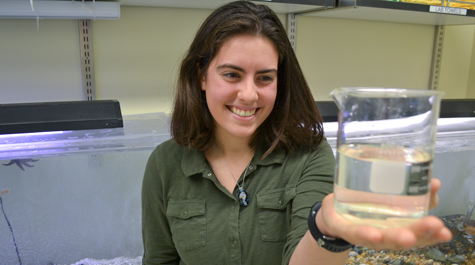Undergrad research discoveries: Cookie Monster larvae and speck-sized cannibals
Anna Klompen is known in certain circles as Flatworm Mom. Karina Brocco French is developing her own alternate maternal identity: Cannibal Mom.
The moms draw their names from monitoring the curious feeding habits of two different marine invertebrate species. Klompen ’17 and French ’16 made significant discoveries in Jonathan Allen’s lab in William & Mary’s Department of Biology. The two of them made a clean sweep of the undergraduate awards of the Division of Invertebrate Zoology at the annual meeting of the Society for Integrative and Comparative Biology.
Klompen won the award for best student poster and French took the honors for best student talk. Allen points out that both awards were in competition with M.S. and Ph.D. students as well as undergraduates. French won a second award for students who make use of an alternative hypothesis in their research.
“So there are three possible awards in this division and two William & Mary undergrads won all three,” Allen said, noting that the awards recognize real contributions to science by the two young researchers.
A predator the size of your pinky nail
Klompen has been working with Stylochus ellipticus, a species of small marine flatworm that’s a predator on oysters and barnacles. (“I once accidentally called it a ‘parasite’ my freshman year, and I was, ahhh, incorrect,” she said.)
The larvae of Stylochus ellipticus have always been hard to study. The young worms are too small to be seen with the naked eye and it takes a sharp eye to see even a full-sized adult.
“The ones I like — the big ones that lay a lot of eggs for me — I usually tell people they’re the size of my pinky nail to the size of my thumbnail,” Klompen said. “But they range up to a few centimeters.”
The worms are both ecologically and economically important, Allen explained, as the adults will eat barnacles, but seem to prefer oysters. “They’re really good at eating little oysters,” Allen said.
Allen’s lab has been trying to examine the early life stages of Stylochus ellipticus for some time in work funded by a grant from the National Science Foundation. Two previous students had failed at attempts to raise the worms from egg to juvenile stage. Allen admitted that he thought the students were doing something wrong, but Klompen’s work revealed that it was the scientific literature on the little worms that was wrong.
Klompen explained that the literature held that the larvae didn’t need much food. Some authorities even held that the larval stage of the worm didn’t eat at all. They were wrong.
“It turns out that they need a lot of food,” Allen said. “They don’t eat a lot of food. They’re just really, really bad at eating.”
Never invite these things to your fancy dinner
The larvae eat algae, and they require an enormous amount of algae, because Klompen describes their eating habits as “just crashing into the food.” They compare the feeding technique of a young Stylochus ellipticus to that of the Cookie Monster.
“You know: Cookie Monster has a big plate of cookies and he’s like arrgh, arrrgh, arrgh!” Allen said, mimicking the frenzied destruction of a plate of snickerdoodles so well known to viewers of Sesame Street. “And most of the cookie doesn’t go in his mouth; the pieces go over his head and on the floor.”
Aside from the advantages of impelling a professor to imitate a Muppet, Klompen’s insight into the feeding habits of young flatworms has potentially far-reaching implications for the Chesapeake Bay. She has begun a side project based on a hypothesis formulated from observing her young flatworms.
“Over time, in the course of the eutrophication of the bay, the algal levels have gone up so much,” she explained. “Because there’s more algae, there’s more food for these larval flatworms.”
At the same time, Klompen said, oyster restoration efforts are putting more oyster spat on shell in the bay, so there’s more tender baby oysters for the adult worms to eat. More adults mean more eggs. “And so there’s this whole cycle that’s started,” she said.
She is continuing her research, working to determine how much more algae is in the Chesapeake today versus the 1950s, the first step toward testing her hypothesis which hints that increased flatworm predation is a bigger problem for the bay’s oysters than is currently understood.
When your specimens start eating each other
French made her discovery on the feeding habits of juvenile sea stars while pursuing another line of inquiry. She said she was investigating environmental conditions that prompted the animals to grow spines.
Her sea stars are the familiar five-armed “starfish” known mainly by their desiccated corpses that give a nice accent to a display of seashells. Before they’re dried out and placed on a shelf, they occupy a role in the marine food web as a keystone predator.
French explains that a “keystone predator” has a larger impact on their ecological community than their biomass would predict and conducts a major role in shaping the environment.
In the case of sea stars, cannibalism is a part of the keystone predator role. Marine scientists have known for a long time that adult sea stars are cannibals, but just as Klompen was the first to discover that her flatworm larvae actually eat, French is the first to record cannibalism among juvenile sea stars. Her discovery was a happy accident.
As juveniles, sea stars become covered with spines, “like weird little porcupines,” Allen said, in contrast to their knobby adult bodies. French had planned an experiment based on a hypothesis that the presence of predators had an effect on spine growth in the baby sea stars. Her methodology was basically to put a number of sea stars in a dish, then introduce a predator cue — a chemical identified with some organism that eats little sea stars.
A cannibal the size of a grain of sand
She didn’t get very far, because her specimens, one after another, began disappearing. It didn’t take long for the disappearances to start and it didn’t take long to figure out what was happening.
“They’ve just metamorphosed. They’ve just turned from that larval stage and become sea stars. They’re one or two days old and about the size of a grain of sand,” French said. “And they're already old enough to eat each other, which is insane.”
“Even though they’ve been really well fed as larvae, and you think you’ve treated them well, they cannibalize their siblings,” Allen said.
While Klompen’s flatworm larvae eat by the Cookie Monster, crash-and-thrash method, juvenile sea stars essentially set a trap for each other.
“The juvenile that’s the cannibal will place its oral surface — where the stomach is — exposed to the juvenile that it’s going to eat,” French explained. “And it just kind of extrudes the stomach lining and just kind of externally digests its brother or sister.”
The discovery that her lab specimens were eating each other came as a blow to French, especially as the sea stars began eating each other even before she could introduce the predator cues.
“I was really angry,” she said. “This was supposed to be my honors thesis and it was November! ”
She switched the focus of her research from spine growth in sea stars to cannibalism and prepared a set of new questions.
“First we wanted to see that behavior in a controlled environment, because we came upon it by accident, so we wanted to see if what we thought was happening was actually happening,” she said.
It was. It didn’t take long for a carefully watched beaker of juvenile sea stars to start showing a drop in the census.
Size matters. So does population density
“Then we wanted to determine if that cannibalistic behavior depended on the size of the juveniles and at natural densities like you would find in the field,” French explained. “Finally we wanted to see if that behavior would occur if they had other food sources available to them.”
She found that the frequency of cannibalism increased with density of the specimens and also that the little things ate each other at densities that would be found in the field.
“We also found that cannibalism was size-specific,” French added. “So, juveniles that are greater in size are more likely to be the cannibalistic juvenile. And the greater the size difference in the pair, the more likely that pair is to exhibit cannibalism.
“And,” she concluded, “we found that they cannibalize each other in the presence of an alternative food source, which for them is juvenile mussels. It didn’t matter; they ate each other as well as the mussels.” Skip to main content
Skip to main content


